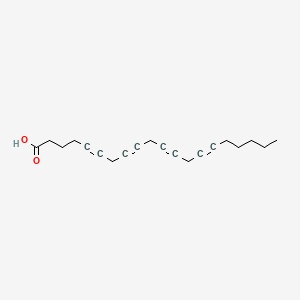| Bryman I et al. |
Influence of prostaglandins on contractility of the isolated human cervical muscle. |
1984 |
Obstet Gynecol |
pmid:6583598
|
| Wilson DE et al. |
Ultrastructural evidence for differentiation in a human glioblastoma cell line treated with inhibitors of eicosanoid metabolism. |
1990 |
Neurosurgery |
pmid:2234352
|
| el-Etr M et al. |
A monoclonal anti-idiotypic 'internal image' antibody that recognizes the A1 adenosine receptor potentiates the alpha 1-adrenergic activation of phospholipase C in primary cultures of mouse striatal astrocytes. |
1992 |
Neurosci. Lett. |
pmid:1334241
|
| Bandell M et al. |
Noxious cold ion channel TRPA1 is activated by pungent compounds and bradykinin. |
2004 |
Neuron |
pmid:15046718
|
| Fry C et al. |
Cytokine-mediated growth hormone release from cultured ovine pituitary cells. |
1998 |
Neuroendocrinology |
pmid:9734004
|
| Vlaskovska M and Knepel W |
Beta-endorphin and adrenocorticotropin release from rat adenohypophysis in vitro: evidence for local modulation by arachidonic acid metabolites of the cyclooxygenase and lipoxygenase pathway. |
1984 |
Neuroendocrinology |
pmid:6092988
|
| Roudbaraki MM et al. |
Arachidonic acid-induced hormone release in somatotropes: involvement of calcium. |
1996 |
Neuroendocrinology |
pmid:8677013
|
| Sterin-Borda L et al. |
Effect of phytohemagglutinin-stimulated human lymphocytes on isolated rat atria. Participation of lipoxygenase products of arachidonic acid metabolism. |
1983 |
Naunyn Schmiedebergs Arch. Pharmacol. |
pmid:6415490
|
| Jobke A et al. |
On the relation between release of prostaglandins and contractility of rabbit splenic capsular strips. |
1976 |
Naunyn Schmiedebergs Arch. Pharmacol. |
pmid:934353
|
| Nemeth EF and Douglas WW |
Calmodulin, phospholipase, and exocytosis. p-Bromophenacyl bromide inhibits but mepacrine stimulates secretion in rat mast cells. |
1983 |
Naunyn Schmiedebergs Arch. Pharmacol. |
pmid:6633678
|
| Diekmann JM et al. |
Angiotensin II-induced contractions of rabbit splenic capsular strips and release of prostaglandins. Use of radioimmunoassays for prostaglandins E1 and E2. |
1977 |
Naunyn Schmiedebergs Arch. Pharmacol. |
pmid:857170
|
| Spies C et al. |
Inhibitory effects of mepacrine and eicosatetraynoic acid on cyclic GMP elevations caused by calcium and hormonal factors in rat ductus deferens. |
1980 |
Naunyn Schmiedebergs Arch. Pharmacol. |
pmid:6245377
|
| Suthanthiran M et al. |
Hydroxyl radical scavengers inhibit human natural killer cell activity. |
1984 Jan 19-25 |
Nature |
pmid:6694728
|
| Friedman J et al. |
Chromium chloride induces chromosomal aberrations in human lymphocytes via indirect action. |
1987 Jul-Aug |
Mutat. Res. |
pmid:3114632
|
| Emerit I et al. |
Suppression of tumor promoter phorbolmyristate acetate-induced chromosome breakage by antioxidants and inhibitors of arachidonic acid metabolism. |
1983 |
Mutat. Res. |
pmid:6877258
|
| Sobotka AK et al. |
Indomethacin, arachidonic acid metabolism and basophil histamine release. |
1979 |
Monogr Allergy |
pmid:91953
|
| Hamiduzzaman MM et al. |
beta-Aminobutyric acid-induced resistance against downy mildew in grapevine acts through the potentiation of callose formation and jasmonic acid signaling. |
2005 |
Mol. Plant Microbe Interact. |
pmid:16134894
|
| Alaoui-El-Azher M et al. |
Arachidonic acid differentially affects basal and lipopolysaccharide-induced sPLA(2)-IIA expression in alveolar macrophages through NF-kappaB and PPAR-gamma-dependent pathways. |
2002 |
Mol. Pharmacol. |
pmid:11901217
|
| Tsai SC et al. |
Effects of nitroprusside on the bradykinin responsiveness of human fibroblasts. |
1986 |
Mol. Pharmacol. |
pmid:3018483
|
| Gut J et al. |
Conversion of 5-hydroperoxyeicosatetraenoic acid into leukotriene B4 by rat hepatocytes: a novel cellular source for leukotriene B4. |
1988 |
Mol. Pharmacol. |
pmid:2843745
|
